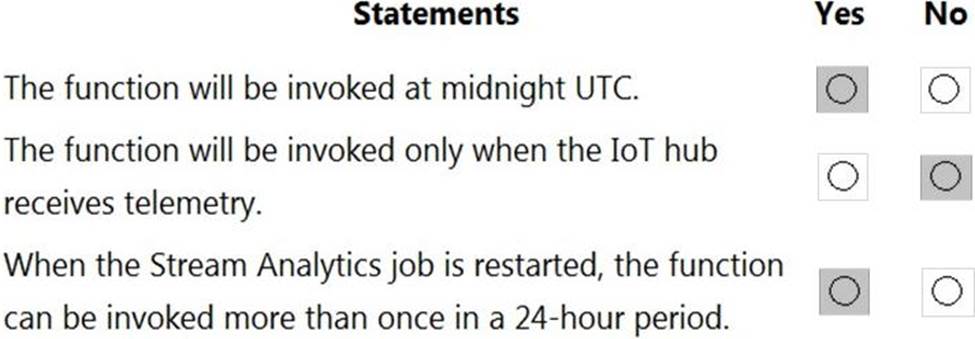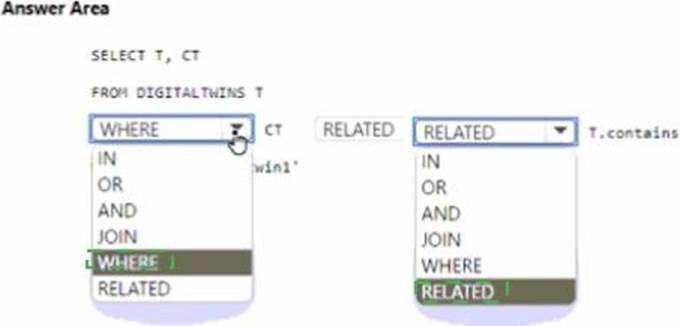Microsoft AZ-220 Microsoft Azure IoT Developer Online Training
Microsoft AZ-220 Online Training
The questions for AZ-220 were last updated at Oct 28,2025.
- Exam Code: AZ-220
- Exam Name: Microsoft Azure IoT Developer
- Certification Provider: Microsoft
- Latest update: Oct 28,2025
You have an Azure IoT hub that is being taken from prototype to production.
You plan to connect IoT devices to the IoT hub. The devices have hardware security modules (HSMs). You need to use the most secure authentication method between the devices and the IoT hub. Company
policy prohibits the use of internally generated certificates.
Which authentication method should you use?
- A . an X.509 self-signed certificate
- B . a certificate thumbprint
- C . a symmetric key
- D . An X.509 certificate signed by a root certification authority (CA).
Note: This question is part of a series of questions that present the same scenario. Each question in the series contains a unique solution that might meet the stated goals. Some question sets might have more than one correct solution, while others might not have a
correct solution.
After you answer a question in this question, you will NOT be able to return to it. As a result, these questions will not appear in the review screen.
You have devices that connect to an Azure IoT hub. Each device has a fixed GPS location that includes latitude and longitude.
You discover that a device entry in the identity registry of the IoT hub is missing the GPS location.
You need to configure the GPS location for the device entry. The solution must prevent the changes from being propagated to the physical device.
Solution: You use an Azure policy to apply tags to a resource group. Does the solution meet the goal?
- A . Yes
- B . No
You have an Azure IoT solution that includes a basic tier Azure IoT hub named Hub1 and a Raspberry Pi device named Device1. Device1 connects to Hub1.
You back up Device1 and restore the backup to a new Raspberry Pi device.
When you start the new Raspberry Pi device, you receive the following error message in the diagnostic logs of Hub1: "409002 LinkCreationConflict."
You need to ensure that Device1 and the new Raspberry Pi device can run simultaneously without error.
Which two actions should you perform? Each correct answer presents part of the solution. NOTE: Each correct selection is worth one point.
- A . On the new Raspberry Pi device, modify the connection string.
- B . From Hub1, modify the device shared access policy.
- C . Upgrade Hub1 to the standard tier.
- D . From Hub1, create a new consumer group.
- E . From Hub1, create a new IoT device.
Note: This question is part of a series of questions that present the same scenario. Each question in the series contains a unique solution that might meet the stated goals. Some question sets might have more than one correct solution, while others might not have a correct solution.
After you answer a question in this section, you will NOT be able to return to it. As a result, these questions will not appear in the review screen.
You have 20 IoT devices deployed across two floors of a building. The devices on the first floor must be set to 60 degrees. The devices on the second floor must be set to 80 degrees.
The device twins are configured to use a tag that identifies the floor on which the twins are located.
You create the following automatic configuration for the devices on the first floor.
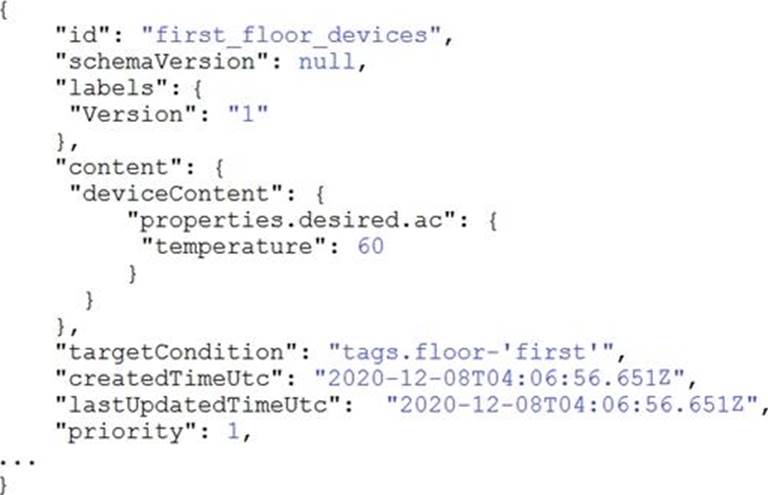
You create the following automatic configuration for the devices on the second floor.
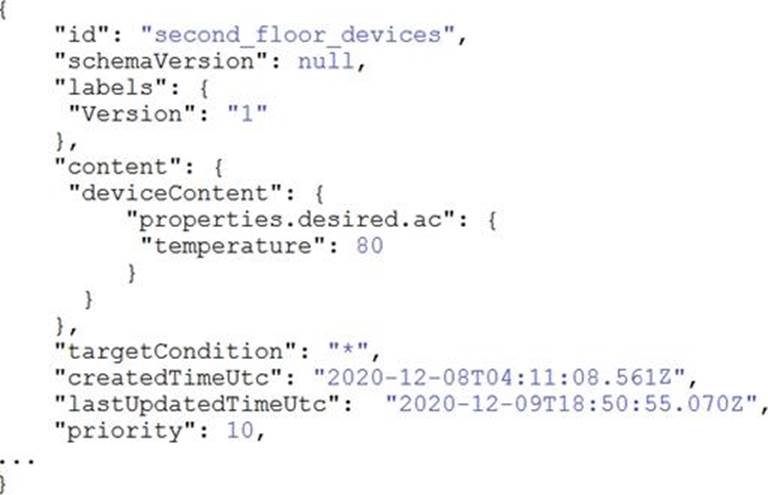
The IoT devices on the first floor report that the temperature is set to 80 degrees.
You need to ensure that the first-floor devices are set to the correct temperature.
Solution: In the automatic configuration for the second-floor devices, you set targetCondition to "tags.floor=’second’".
Does this meet the goal?
- A . Yes
- B . No
Note: This question is part of a series of questions that present the same scenario. Each question in the series contains a unique solution that might meet the stated goals. Some question sets might have more than one correct solution, while others might not have a correct solution.
After you answer a question in this section, you will NOT be able to return to it. As a result, these questions will not appear in the review screen.
You are developing a custom Azure IoT Edge module.
The module needs to identify the device ID of the local device.
Solution: You configure the module to read the ProductInfo property of ModuleClient.
Does this meet the goal?
- A . Yes
- B . No
You have 10,000 IoT devices that connect to an Azure IoT hub. The devices do not support
over-the-air (OTA) updates.
You need to decommission 1,000 devices. The solution must prevent connections and autoenrollment for the decommissioned devices.
Which two actions should you perform? Each correct answer presents part of the solution. NOTE: Each correct selection is worth one point.
- A . Update the connection State device twin property on all the devices.
- B . Blacklist the X.509 root certification authority (CA) certificate for the enrollment group.
- C . Delete the enrollment entry for the devices.
- D . Remove the identity certificate from the hardware security module (HSM) of the devices.
- E . Delete the device identity from the device registry of the IoT hub.
HOTSPOT
You create an Azure Stream Analytics job that has the following query.

The job is configured to have an Azure IoT Hub input and an output to an Azure function.
For each of the following statements, select Yes if the statement is true. Otherwise, select No. NOTE: Each correct selection is worth one point.
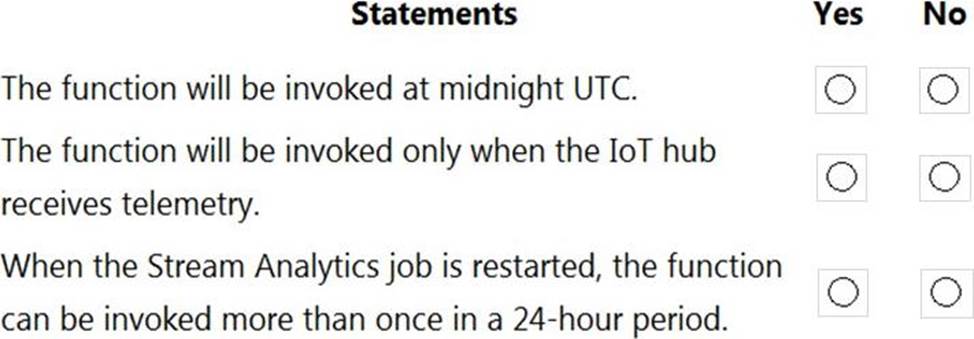
You need to route events in Azure Digital Twins to a downstream service for additional processing.
Which type of output endpoint can you use?
- A . Azure Event Hubs
- B . Azure Queue storage
- C . Microsoft Power Bl
- D . Azure Table storage
HOTSPOT
You are creating an Azure Digital Twins Query.
You need to return all the digital twins that have a contains relationship with a digital twin that has an ID of twin1.
How should you complete the query? To answer, select the appropriate options m the answer area. NOTE: Each correct selection is worth one point.
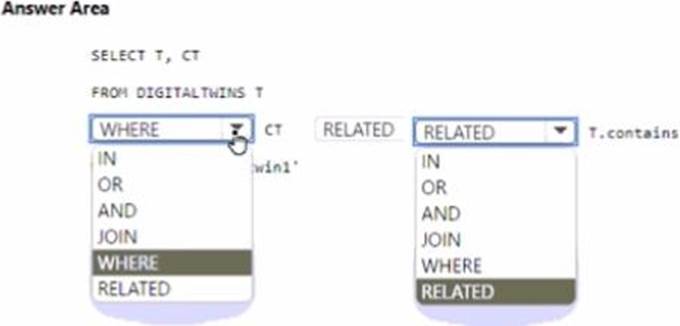
Note: This question is part of a series of questions that present the same scenario. Each question in the series contains a unique solution that might meet the stated goals. Some question sets might have more than one correct solution, while others might not have a correct solution.
After you answer a question in this section, you will NOT be able to return to it. As a result, these questions will not appear in the review screen.
You are developing a custom Azure IoT Edge module.
The module needs to identify the device ID of the local device.
Solution: You configure the module to read the IOTEDGE_DEVICEID environment variable.
Does this meet the goal?
- A . Yes
- B . No
Latest AZ-220 Dumps Valid Version with 88 Q&As
Latest And Valid Q&A | Instant Download | Once Fail, Full Refund

